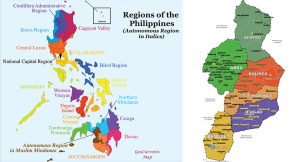Traitement choral: 7 œuvres chorales de la Cordillère (Philippines) à inclure dans votre prochain programme
The intricate play of rhythm, the fast-slow-fast structure, the use of open fifths to reimagine the organic space, the quartal harmonies and occasional dissonances to reproduce the overtones, the tonal and timbral emulating of elderly chanters, the textual permutations that contribute to the percussive properties of the arrangements, as well as the improvised inclusion of an ethnic drum, various bamboo instruments, and even body percussions – these are just some of the appealing qualities that make arrangements and even compositions based on Cordilleran materials very interesting. Here’s hoping that the next time you prepare a world music segment for one of your concerts, these are some pieces from the Cordillera region worth including in your programme.

7. Dumbele
Originally written for female voices by the late Rodolfo Delarmente, he eventually transcribed it into SATB and has since became a staple piece among Filipino choirs. It was based on an Itneg/Tinguian rain chant as documented in fieldwork by Ramon Obusan (National Artist for Dance) to accompany his suite of animist and pagan ritualistic dances. Delarmente’s rich visualisation through polychoral layering and exceptional command of contrapuntal and countermelodic writing became his trademark style, as evidenced by his other works such as Ilay Gandangan (Worship of the Sun) from the southern Philippines and his Ama Namin (Our Father).
The text of the entire piece is based on two very simple and short phrases: Dumbele sekatemaya, Dumbele malateka – making it text-friendly even for non-speakers of the language. Dumbele was published by Carus Verlag.
6. Salidummay
There are several existing choral versions of this famous Cordilleran phrase and tune. Although there are similarities like the presence of rhythm and syncopation, each version offers a distinct flavour. One factor is that the Salidummay’s melody, tempo, and even texts vary depending on the context in which it is sung. In addition, each of the six provinces of the Cordillera region have their own variants of the Salidummay. A relatively recent version by Normita “Bing” Pablico featured a male soloist to start the piece and generally chose a more prayerful mood (for the solo and the solemn legato parts in the middle), with the more festive and rhythmic parts depicting their ritual of thanksgiving. Bienvenido Constantino’s arrangement, on the other hand, uses a simpler motif but pushes the limits of range and even includes changing meters through constant motific augmentation and diminution as each segment progresses.
Vocal jazz pioneer Moy Ortiz’s arrangement in the mid-90s explored complementary rhythms between simple-triple and compound-duple meter, long before modern composers utilised them in choral writing. The score was unpublished but was recorded by the Ateneo Glee Club under Dr. Joel Navarro as part of their 1995 album aptly titled ‘Lahi: The Filipino Sings from the Heart’.
An earlier arrangement of the Salidummay was written by Reynaldo Paguio of the University of the Philippines Concert Chorus. Paguio’s version was actually based on a recording from ethnomusicological fieldwork in the Cordilleras. The field recordings featured a Tongali (bamboo nose flute) that was played by a virtuoso master flautist. Paguio opted to use a western flute to replicate the articulation. This was part of the Mga Awiting Bayan collection of folk songs published by the Philippine Madrigal Singers and edited by Professor Andrea Veneracion (National Artist for Music).
5. Orde-e
Originating from the Madukayan tribe of Mountain Province, this Lester Delgado arrangement was one of the winning pieces included in Mga Awiting Bayan para sa Korong Pilipino published by the National Commission for Culture and the Arts. Another musical painting of the Cordilleran landscape, Delgado’s Orde-e features a male and female soloist. Generally tranquil in character, with punctuations of rhythmic activity in the development section before returning home to a state of calmness. Maria Theresa Vizconde-Roldan wrote an accompanied SSAA version of Orde-e which was published by Hal Leonard.
4. Iddemdem Malida
For quite some time, this was classified as an Itneg/Tinguian war song from the province of Abra. However, it was later suggested that it might not really be a song of war, but of victory. This small detail carries very important information affecting both how the song should be sung and how its choral arrangements should be interpreted – festive and celebratory, but not necessarily aggressive.
There have been different choral arrangements of this tune; the earliest version was by the late Elmo Makil, arranged for SATB and published by Alfred Music. Still based on Makil’s chant was a more recent arrangement by Jonaf Del Fierro, this time for TTBB and published by Pavane Publishing. A slightly modernist upgrade, Del Fierro’s work also clearly defined the segments, creating a more cohesive structural narrative.
Ryan Cayabyab (National Artist for Music) wrote a larger concert arrangement of this same folk tune which featured a trio of soloists, a double choir, a rhythm section, and various Philippine indigenous instruments.
3. Chua-Ay
Traditionally, this Igorot folk tune from Benguet is sung while pounding rice grains using a huge mortar after the grains have been shredded from their stems. It is already quite obvious that the pounding makes for natural percussive rhythms that are easy to sing along to. A closer examination presents the opposite – it is the rhythm and the singing that makes the pounding easier and faster.
The earliest choral version known to Philippine choirs was that of Fabian Obispo. Years later, Prof. Fidel Calalang included Chua-ay as part of his choral suite Ayug ti Amianan (Scenes from the North). Although the sections are entirely independent of one another, Calalang’s arrangement provided the complete picturesque narrative. Nevertheless, both versions embodied the rhythmic and percussive properties of the song’s original function.
Obispo’s work was published by Carus Verlag, included in the Philippine Madrigal Singers’ Mga Awiting Bayan and has an unpublished TTBB version transcribed by Emmanuel Laureola. Calalang’s arrangement, on the other hand, was published by Earth Songs and has an SSAA version transcribed by Jude Roldan and published under Muziksea.
2. Vochong
Depicts the Cordilleran tradition of forging peace pacts between rival groups or clans. Vochong, Bochong, or Bodong literally translates to peace pact. This folk tune from Kalinga was arranged by Dyzon Pesquera for mixed voices, gongs, and bamboo instruments. Pesquera’s ability to use unexpected transitions is one of the many high spots of this arrangement. It is a masterclass in textural development achieved through fragmentations of the theme to smoothly shift from unison to canon, slowly building up to its high point characterised by a contrapuntal exchange among voice sections.
-
Gapas
Topping our list is Gapas (Harvest) – a composition by Eudenice Palaruan based on a biblical text about reaping a harvest in the vernacular language. Palaruan, whose roots are from Lamut, Ifugao is one of today’s leading composers, arrangers, and advocates for Philippine and Asian choral literature. Written for SSAATTBB with sub-divisions, Gapas is a vocally demanding work which requires a larger number of singers with highly advanced technical and musical skills. Part of the genius of this composition is Palaruan’s exploration of using an interesting motif (E – D# – A – G) horizontally (melodic) and vertically (harmonic) in moto perpetuo. The clusters emulate the partials (harmonic overtones) produced by Cordilleran gong playing while the hemitonic pentatone can actually be heard with Cordilleran melodic instruments such as the Tongali (nose flute), Paldong (lip-valley flute), or the Kolitong (bamboo zither). As someone who actually comes from the Cordillera region, Palaruan has written several choral works in which he used Ibaloi, Ifugao, and Kankana-ey text, contributing to his very own heritage, such as his composition Ehikier 37 (Ezekiel 37) and arrangements of the Tinguian Oggayam, and the Kankana-ey melody Pundayaw hi Apu Infaag.
For inquiries regarding the music listed above, you may contact the Philippine Choral Directors Association via www.mypcda.com.
Edited by Lydia de Montfort, UK
